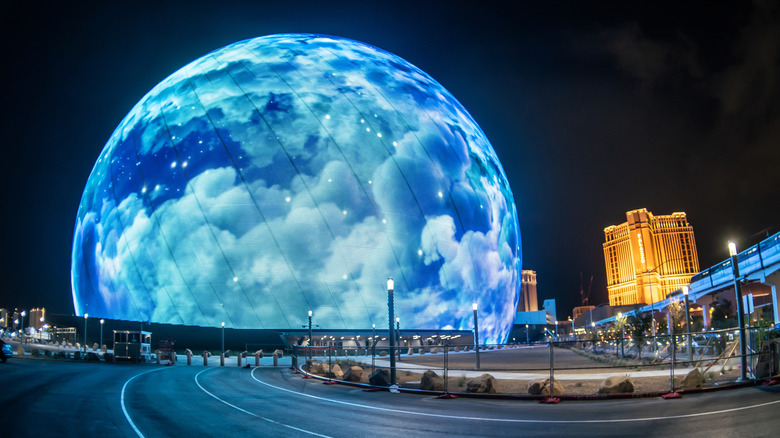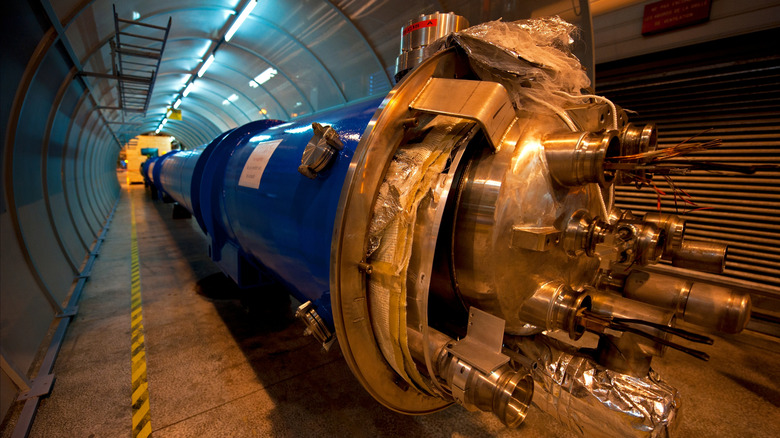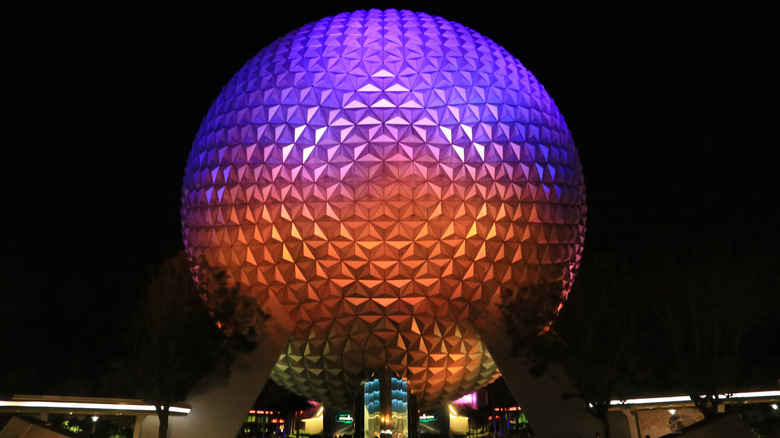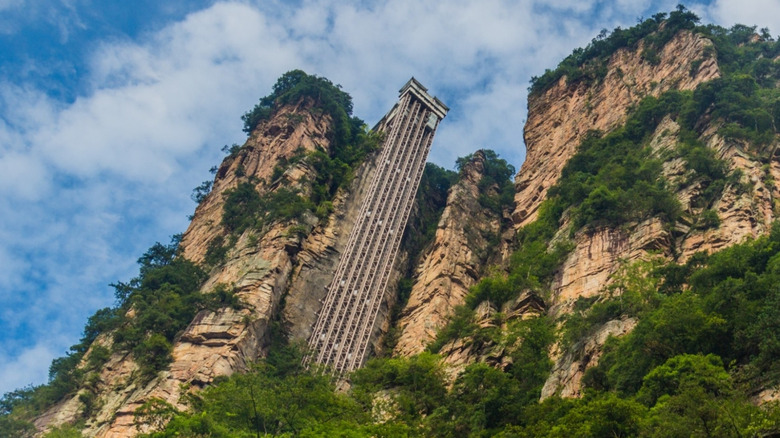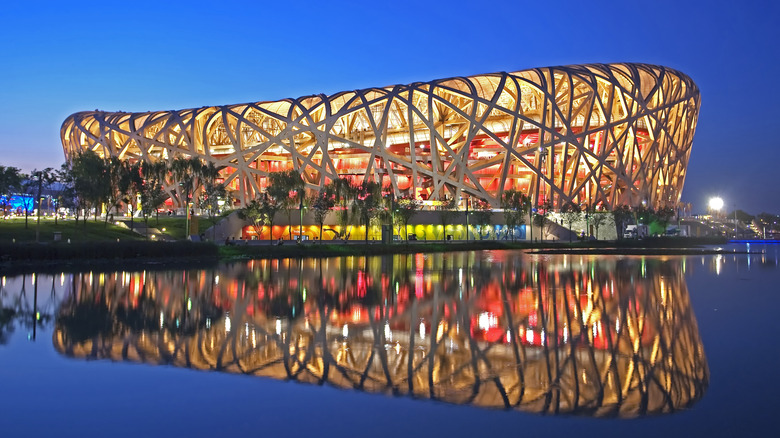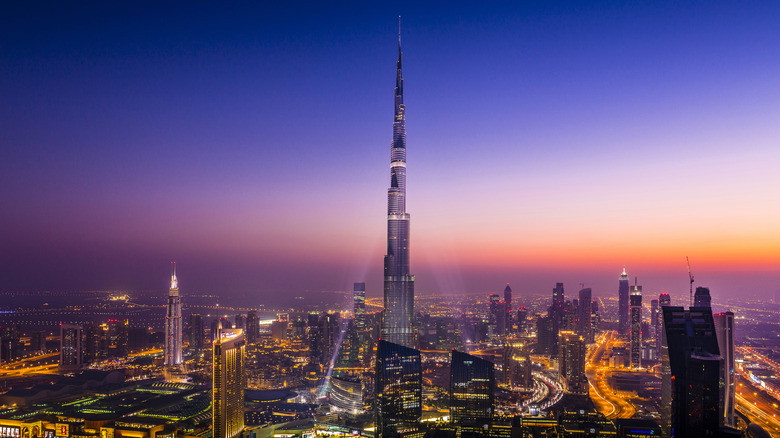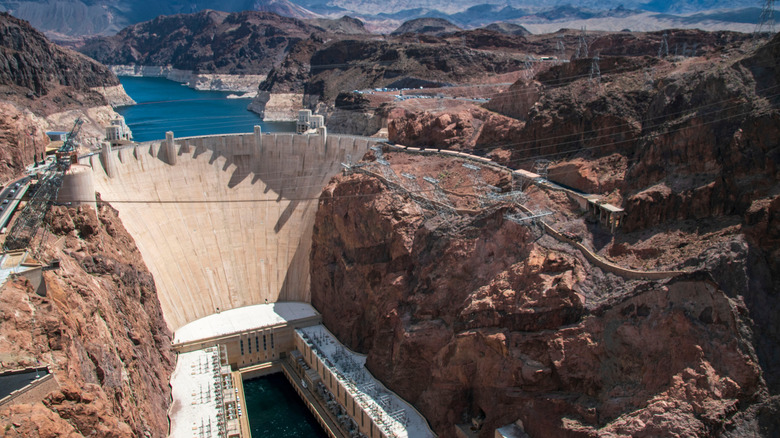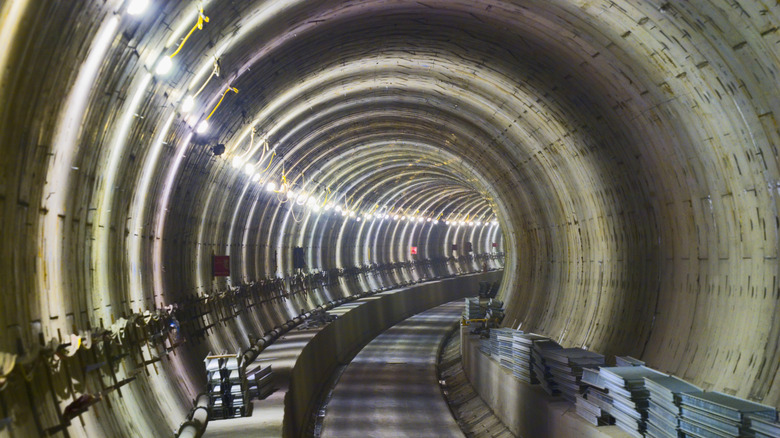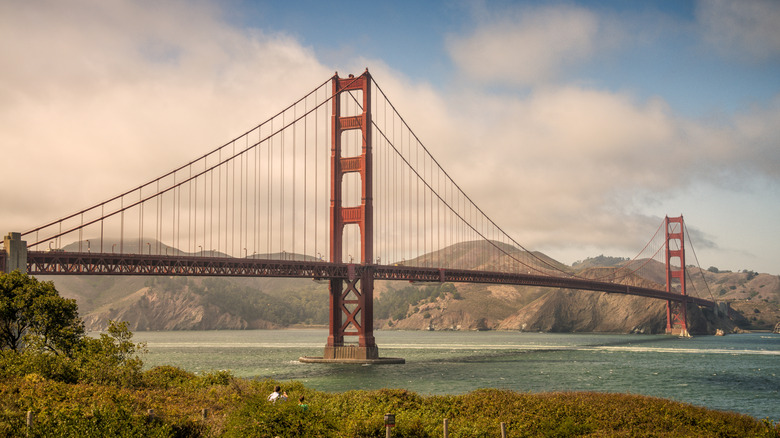9 World Class Attractions And The Tech Behind Them
Localities will go to great lengths to attract tourism, but what happens when there is no natural wonder to gawk at? Build it, and they will come. The world is filled with engineering and technological marvels that make great vacation destinations, and many of them welcome additional dollars by offering tourists a chance to get up close to their favorite landmark.
Necessary infrastructure, vanity projects, and scientific facilities all fall into this category of eye-popping projects attracting millions of visitors annually. You don't need to be a science or engineering enthusiast to enjoy some of these attractions. From The Sphere concert venue in Las Vegas to the Golden Gate Bridge in San Francisco, these amalgamations of imagination, technological wizardry, and engineering mastery impress nonetheless.
Come along with us as we travel to the far corners of the earth to uncover some of the most exciting and impressive world-class attractions and the technology that makes them possible.
The Sphere
After opening in 2023, the Las Vegas Sphere instantly became one of the most recognizable concert venues in the world. Looming over the infamous Strip, the aptly named Sphere is a technological marvel.
Standing at 366 feet tall and 516 feet, the building is the largest spherical structure in the world, but that's not where the wonders end. The Sphere is actually two structures, a dome within a dome. An outer exoskeleton carries a 580,000-square-foot LED display that projects everything from Super Bowl ads to an enormous eyeball that watches over Sin City, while inside is an utterly unique concert venue.
The second dome is 30% smaller than the first one but no less impressive. It is a 160,000-square-foot (15,000 square meters) LED display that wraps up to 20,000 audience members in whatever multimedia the artist has designed. Artists are invited to create in Sphere Studio, a production facility with a scaled-down version of the Sphere. Media designed for flat screens would be wasted on such a marvel.
With $2.3 billion, 32,000 tons of steel, and the organizational ability to pull off a massive construction project in the center of one of America's most iconic neighborhoods, you too could have your very own Sphere. Failing that, a trip to Vegas to see your favorite artist, or even just ogle at it from the sidewalk, might be a bit more sensible.
CERN Hadron Collider
If simulating the condition of the universe before the Big Bang sounds like your kind of vacation, look no further than the campus of the CERN Hadron Collider. The largest particle accelerator on earth is a 17-mile ring buried 328 feet below ground outside of Geneva, Switzerland.
This is where scientists go to find out what happens when two particles collide in a vacuum at nearly the speed of light. Remember when you built your Hot Wheels tracks in a loop and placed as many accelerators as possible along the track? The Hadron collider does that, except it replaces metal cars with hadrons, accelerating them around the loop before smashing them together at near-light speeds. It is where the scientific community tries to answer these questions:
- What is the origin of mass?
- Will we discover evidence for supersymmetry?
- What are dark matter and dark energy?
- Why is there more matter than antimatter in the universe?
- What happened in the first microseconds after the Big Bang?
You know, basic stuff.
While it might not top the bucket list like a trip to Cancun or the Eiffel Tower, true enthusiasts can visit CERN free of charge and attend tours, exhibitions, lectures, and other public events. They won't let you in the tunnel, but who wants a Higgs-Boson God particle wedged in their forehead anyway?
Spaceship Earth
The Disney Company has spent the last 50 years creating unique and jaw-dropping attractions for its amusement parks. Disney calls the people who partake in theme park engineering Imagineers, and that says it all. Imagination and engineering have combined to create some of the most iconic and technologically advanced attractions in any amusement park.
Spaceship Earth is the flagship attraction at Disney's Epcot Center in Orlando, Florida. Considered a "dark ride," Spaceship Earth features slow-moving cars ferrying guests past dimly lit scenes that detail humanity's history on Earth. Animatronics play out a scene at each stop. The ride relies on storytelling rather than thrilling physical experiences to entertain riders.
Though the ride within the Epcot ball (officially known as Spaceship Earth, Epcot) is impressive, the distinctive structure is nothing less than a feat of architecture. Walt Disney wanted a memorable and recognizable statement at the entrance to Epcot. What better than an enormous sphere made entirely of triangles?
The resulting geodesic sphere, designed and constructed over 26 months, would be one of the largest in the world. Design firm Simpson, Gumpertz, & Heger developed a 160-meter dome made of stamped steel and composite aluminum. A layered structure allows Florida's torrential rain to drain into a second rubberized layer that directs the rain into a gutter system.
The Spaceship Earth ride might not be the most technologically advanced or thrilling ride in the Disney ecosystem. Still, fans of geometry and building will drool over its incredible architectural feats.
Bailong Elevator
The Zhangjiajie National Forest in Hunan, China, is a breathtaking repository of natural beauty. Some believe it is the basis of the awe-inspiring scenery in the Avatar films. Its towering cliffs and dramatic landscapes draw visitors from all over the world.
In 1999, construction began on the Bailong Elevator, an outdoor elevator that, once completed in 2002 at a cost of about $26 million, became the tallest outdoor elevator in the world. Built into a sandstone cliff, the 1,100-foot outdoor elevator takes up to 50 tourists to the top of the cliff at a time.
The elevator has been open for twenty years, but its environmental impact on the area remains to be seen. Building an enormous industrial elevator in the center of a natural refuge was controversial. Detractors feared it would mar the beauty of the park. However you may feel, there's little doubt that the Bailong Elevator has changed the park experience.
It used to take a three-hour ride through treacherous mountain roads to truly appreciate the park's beauty. Now, tourists can bypass all that by taking the elevator up. It makes the ascent in a mere minute and a half. If you're interested in a workout and perhaps some Chinese prison time, you can climb it. That's just what French climber Jean-Michel Casanova did in 2023. Or you could just buy a ticket. It's less stressful.
Bejing National Stadium (Bird's Nest)
What sets the National Stadium of Beijing apart is not just its sheer size, but its unique and intriguing design. Crafted by Swiss architects Jacques Herzog and Pierre du Meuron, who drew inspiration from the intricate weaves of a bird's nest, the stadium is a mesmerizing blend of steel and concrete. Herzog and du Meuron's design maximized the use of natural light, ensured the building's resilience to earthquakes, and incorporated green technologies like rainwater collection, making it a marvel of modern architecture.
The National Stadium of Beijing, affectionately known as the Bird's Nest, stands out with its unique design. Construction began in 2003 on a gently sloping foundation that gives the impression the stadium is emerging from the earth. After five years and an investment of $33 million, Beijing proudly unveiled its new stadium in 2008. The sprawling structure covering nearly 3 million square feet and can accommodate up to 91,000 spectators.
Unlike some Olympic venues that fade into obscurity after the games, China had a different vision for its stadium. The National Stadium of Beijing, affectionately known as the Bird's Nest, was designed to have a life beyond 2008. Today, it is a vibrant part of the city's cultural fabric, a beloved feature of the Beijing skyline, and a bustling venue for a wide range of sporting and recreational events. Its enduring legacy continues to connect people and communities, making it a top-class attraction in the Beijing area.
Burj Khalifa
The tallest building in the world will always be a draw for tourists. While the mysterious Great Pyramid held the title for nearly 4,000 years, the past few hundred have been rough for the long-time champ. Initially overtaken by the Lincoln Cathedral in 1311, a succession of skyscrapers through the 20th century continued to up the ante. However, even former record holders like the Empire State Building can't hold a candle to the reigning king.
Jutting out of the skyline in downtown Dubai, United Arab Emirates, the Burj Khalifa is distinctive for its architecture and incredible height. Designed by Chicago architectural firm Skidmore, Owings, & Merrill, the final height was kept secret throughout construction. Upon its opening in 2010, the 163-story building was not yet finished inside but reached a record height of 2,707 feet.
The Burj Khalifa is arranged in a triple-lobed footprint and supported by a foundation of more than 121,000 tons of concrete. In its quest to become the tallest free-standing structure in the world, the Burj Khalifa also breaks a few ancillary records. It has the highest outdoor observation deck and occupied floor in the world.
Suppose you are heading to Dubai and are a fan of architecture and engineering. In that case, the Burj Khalifa hosts hotels, and many others in the area have stunning views of the contemporary construction wonder.
Hoover Dam
Upon completion in 1935, the Hoover Dam on the Colorado River at the border between Arizona and Nevada was the largest in the world. Toward the beginning of the 20th century, farmers had been diverting the Colorado River to irrigate farms in the southwestern United States. The federal government stepped in when the canals broke, flooding the area now known as the Salton Sea.
It was the Great Depression, and a public works project such as an enormous hydroelectric dam could put people to work. Not to mention the resulting benefits to the area, including preventing disastrous floods of the Colorado, providing irrigation water for farm fields, and generating an annual average of 4 billion kilowatt-hours of hydroelectric power for use in California, Nevada, and Arizona. If you're curious about how dams generate electricity, read our feature explaining it.
A total of 21,000 men labored on the dam. On any given day throughout its five-year construction process, the worksite had between 3,500 and 5,215 workers. Incredibly, this massive project finished ahead of schedule. Given seven years from April 20, 1931, to complete the contract, the concrete placement was finished by May 29, 1935, and the dam was completed on March 1, 1936. During that time, the project excavated 5,500,000 cubic yards of material and placed another 1,000,000 cubic yards of earth and rock.
Today, the Dam sits a mere 45-minute drive from Las Vegas and receives up to 7 million visitors per year, a million of whom opt to tour the incredible facility.
The Chunnel
The narrow spit of water between France and England held the island nation apart from continental Europe for centuries.That all ended on May 6, 1994, when England and France became inextricably linked via the Chunnel.
It's an ugly name for an ugly project. A portmanteau of channel and tunnel, the Chunnel connects Folkestone, England to Sangatte, France via a train tunnel burrowed into the substrata beneath the seafloor of the English Channel.
The line consists of three tunnels, lying an average of 148 feet beneath the seabed. Two main tunnels service trains that can carry people, freight, or cars. The third tunnel serves as service access for maintenance and repair. The Channel Tunnel is 31.5 miles long, 23.5 miles of which are beneath the English Channel. At maximum speeds of up to 100 mph, it takes about two hours to travel from London to Paris, once capitals of opposing worlds.
Crews began digging the Chunnel in 1988 using tunnel boring machines (TBMs). Five of these machines, which look like the sandworms from Dune, started in France, while six more began digging from the English side. The teams met on December 2, 1990, with two TBMs facing each other deep under the ground. Since they could not back up, one TBM dug itself into the ground beneath the service tunnel, where it remains today.
While tours of the Chunnel are not available, anyone interested in visiting England and France would do well to buy a ticket aboard one of the most impressive transportation feats in history.
Golden Gate Bridge
Another engineering feat of the Great Depression, the Golden Gate Bridge spans the width of the Golden Gate strait, which connects San Francisco Bay to the Pacific Ocean. The three-mile-long strait is one mile wide and features powerful tidal currents and deep water, all of which made building a bridge over the gap a complex operation.
Engineer Joseph B. Strauss initially submitted a design for a hybrid suspension bridge supported by cantilevered trusses at each end. Convinced to swap for a more elegant pure suspension bridge, Strauss and consulting engineers Leon S. Moisseiff and O.H. Ammann tested the latest engineering theories on a 1:56 scale model.
The Golden Gate Bridge project broke ground on January 5, 1933. It would take four years to complete, with the roadway over the span completing construction on April 19, 1937. About a month later, on May 27, San Francisco burst into celebration as 18,000 people waited to cross the new icon, which has endured earthquakes, harsh weather, and an average of 100,000 vehicle crossings daily.
San Francisco makes the most of its iconic bridge, offering free walking tours for the curious. The area also includes onsite exhibits detailing the history, science, and engineering behind the bridge's construction and maintenance.

